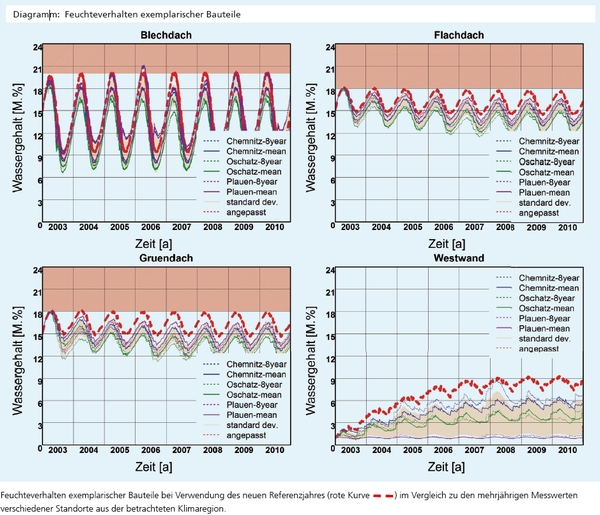Climate data and climate models

The need to reduce CO2 emissions as part of sustainable environmental and climate protection and the responsible use of dwindling energy resources make further optimization of energy consumption in buildings unavoidable.
Considering the climate in Central Europe, it is especially important to improve the insulation of the building envelope and to ventilate buildings efficiently without taking risky shortcuts. Indoor humidity levels rise when the air exchange rate is lowered with the result that, under unfavorable conditions, surface moisture may increase and promote mold growth. Planning or building errors may cause moisture to condense inside the structure. Furthermore, damp materials have a higher thermal conductivity, which may result in unwanted heat loss - a problem that can occur even without structural defects, for example, in roof constructions (e.g. through the migration of trapped moisture) and in retrofitted interior insulation.
On exterior surfaces, the lower temperatures of the insulated components lead to longer condensation periods and therefore a greater risk of microbial growth. From the environmental perspective, the still-common practice of combating this growth with biocides must be viewed as critical because these substances accumulate in the soil and wastewater. In the European Union's new hazardous substances regulations, their application has been restricted even further.
Due to the risks mentioned above, it is becoming ever-more important to plan restorative measures incorporating moisture protection very carefully. The results of state-of-the-art simulation techniques have proven to be very reliable. Provided the required input parameters are available with sufficient accuracy, it is usually possible to make a relatively accurate prediction of the changed temperature and humidity conditions in a structure or interior after an energy-saving renovation measure.
For the outdoor climate, the test reference years issued by the German Weather Service (DWD) have generally been used to date., Although these represent a region's average climate from a thermal point of view, they do not take hygrothermal conditions into account. Most analyses disregard local differences due to elevation, a building's proximity to a forest or lake, or its location in the center of a town, even though in many cases this information could be crucial. Other aspects that cannot be sufficiently differentiated are characteristics specific to a building, such as exposure to driving rain, the impact of ventilated façades or coverings, etc. The climate conditions inside the building, especially in buildings that are only used temporarily or in unheated utility rooms and garages, are largely unknown.
The overall objective of this project is to create a robust and reliable climate database for use with building physics simulation techniques. These in turn contribute to energy-optimized construction methods and support climate-friendly renovation measures for existing buildings. The findings are intended to further cut construction and operating costs (energy savings) while keeping the building envelope free of damage and without impairing its function.
This research project is funded by the German Federal Ministry of Economics and Technology (BMWi) as part of the Research for Energy-optimized Construction EnOB program.